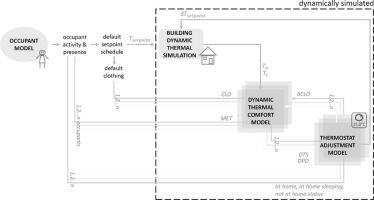Energy and Buildings ( IF 6.7 ) Pub Date : 2021-02-27 , DOI: 10.1016/j.enbuild.2021.110846 Marika Vellei , Simon Martinez , Jérôme Le Dréau

|
Demand Response (DR)-activated smart thermostats can be used to exploit the flexibility of residential heating and/or cooling systems. However, the acceptance/rejection of DR events depends on how occupants interact with their thermostats during the activated setpoint modulations. This interaction is mainly driven by their thermal comfort needs. Thus, understanding and modelling occupants’ comfort-driven interactions with thermostats is crucial for the design, assessment, and control of DR strategies. In this paper, we describe, calibrate, and show the in-use potentialities of a novel framework which is able to model occupants’ interactions with thermostats in residential buildings in winter. The framework includes a stochastic agent-based model of thermostat adjustments, whose dynamic thermal discomfort predictions are based on a two-node thermo-physiological model coupled with a dynamic thermal perception model. This represents a novelty with respect to the most often used static PMV/PPD model. Furthermore, the agent-based model is built on an activity and presence model and, therefore, is able to account for the diversity of the activities carried out by the occupants. User interaction data from about 9,000 connected Canadian thermostats included in the Donate Your Data (DYD) dataset are used to calibrate and establish the empirical foundation of the thermostat interaction model. Finally, we simulate typical DR-activated setpoint modulations in two residential buildings characterized by different levels of insulation and we use the framework to predict occupants’ override rates as a function of the indoor temperature and the time since the start of the DR event. The derived relationship can be directly used to inform the design and control of setpoint modulations in residential buildings.
中文翻译:

基于代理的温度调节器随机模型:需求响应应用
需求响应(DR)激活的智能恒温器可用于开发住宅供暖和/或制冷系统的灵活性。但是,DR事件的接受/拒绝取决于在激活的设定点调制期间乘员如何与其恒温器进行交互。这种相互作用主要是由其热舒适性需求驱动的。因此,了解和建模乘员的舒适性与恒温器的交互作用对于DR策略的设计,评估和控制至关重要。在本文中,我们描述,校准并显示了一种新颖的框架的使用潜力,该框架能够模拟冬季居民住宅中居住者与恒温器的相互作用。该框架包括基于随机代理的温度调节器模型,其动态热不适感预测基于两节点热生理模型和动态热感知模型。相对于最常用的静态PMV / PPD模型,这代表了一种新颖性。此外,基于代理的模型建立在活动和存在模型的基础上,因此能够说明占用者执行的活动的多样性。来自您的“捐赠数据”(DYD)数据集中的约9,000个连接的加拿大恒温器的用户交互数据用于校准并建立恒温器交互模型的经验基础。最后,我们在两个具有不同绝缘水平的住宅建筑中模拟了典型的DR激活的设定点调制,并使用该框架预测了作为室内温度和DR事件开始以来时间的函数的乘员超驰率。导出的关系可以直接用于告知住宅建筑中设定点调制的设计和控制。



























 京公网安备 11010802027423号
京公网安备 11010802027423号